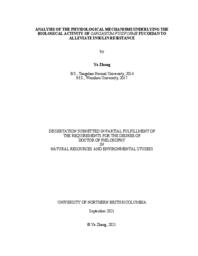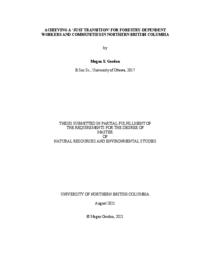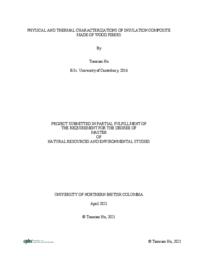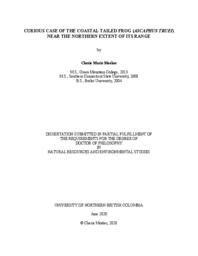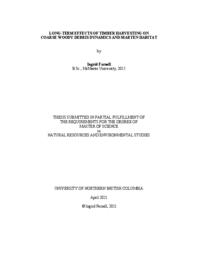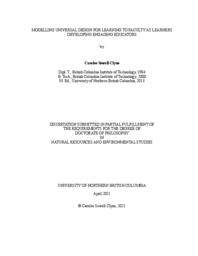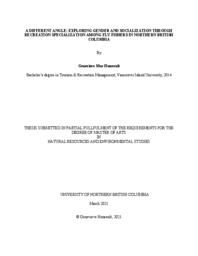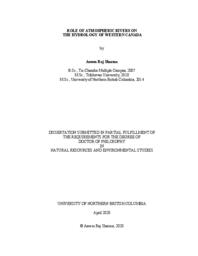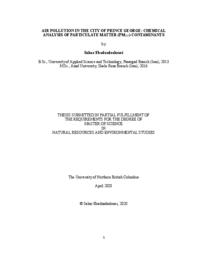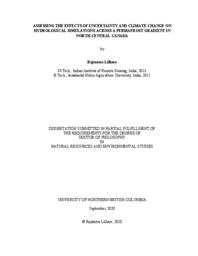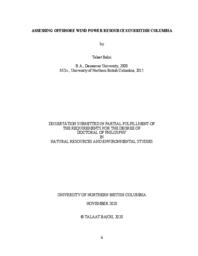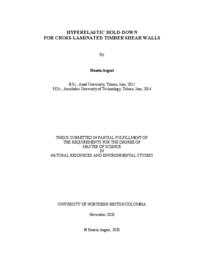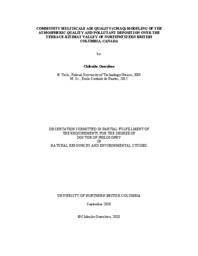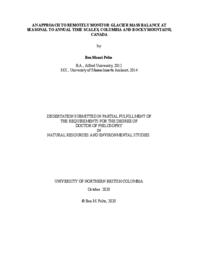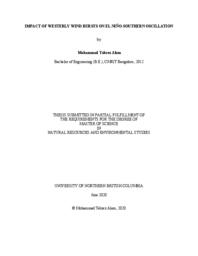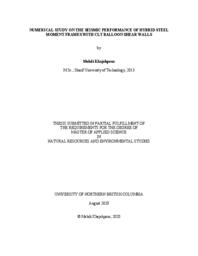University of Northern British Columbia. Natural Resources & Environmental Studies
Related Works
Content type
Digital Document
Description / Synopsis
Type 2 diabetes mellitus (T2DM) is a chronic metabolic disease characterized by hyperglycemia resulting from progressive loss of β-cell insulin secretion frequently on the background of insulin resistance. T2DM, also known as non-insulin-dependent diabetes, accounts for more than 90% of all cases of diabetes. Insulin resistance (IR) refers to the reduced sensitivity of peripheral tissues to insulin and is one of the important triggers of type 2 diabetes. Sargassum fusiforme polysaccharide exhibits diverse biological activities, and more and more studies have shown it has a significant effect in improving insulin resistance with almost no side effects. Sargassum fusiforme fucoidan (SFF) is one of the main active components with active ingredients such as antioxidants and hypoglycemic lipids. However, the ameliorative effects of SFF on high-fat diet-induced insulin resistance mice and its underlying physiological mechanisms are not clear. Hence, the polysaccharides were extracted and purified from Sargassum fusiforme, and fucoidan (SFF), which has good antioxidant activity, was screened using a drosophila melanogaster aging model. The effect of SFF on the amelioration of insulin resistance in mice was investigated with a high-fat obese insulin resistance mice model. By gut microbiota and metabolomics techniques, the effect of SFF on intestinal metabolites and its mechanism of alleviate IR were investigated. After treatment with 200 mg/kg SFF for 8 weeks, it was found that SFF could reduce body weight, fasting blood glucose and homa-IR in insulin resistance mice. SFF could effectively activate Nrf2/ARE antioxidant signaling pathway in the liver and promote Nrf2 entry into the nucleus and downstream gene transcription. Metabolomics and intestinal microecology revealed that SFF could upregulate TUDCA level and downregulate ceramide level in mice colon and serum, and this change was dependent on gut microbiota. TUDCA effectively inhibits the FXR/SHP signaling pathway activated by a high-fat diet, thereby reducing the biosynthesis of enteric-derived ceramides. In addition, TUDCA in the liver could compete with Nrf2 to bind Keap1 to reduce the formation of the Nrf2/Keap1 complex, reduce Nrf2 ubiquitination, and thus contribute to Nrf2/ARE signaling activation. In conclusion, fucoidan from S. fusiforme was able to modulate gut microbiota, increased the levels of the intestinal metabolite TUDCA, reduced biosynthesis of entericderived ceramides and activated the Nrf2/ARE pathway, which in turn significantly improved insulin resistance induced by high-fat diet in mice. This study provides a new research idea for the study of brown algae fucoidan in metabolic diseases.
Origin Information
Content type
Digital Document
Description / Synopsis
Systematic Conservation Planning (SCP) is the practice of comprehensively assessing a landscape for its conservation value via geospatial analysis. This research project applied SCP principles and tools to Tsay Keh Dene Nation Territory in north-central British Columbia, Canada. Working with the Tsay Keh Dene community, we articulated conservation goals and determined important features on the landscape that helped attain those goals. This effort also examined climate change and connectivity impacts on conservation, comparing which lands are most worth conserving today versus 30 and 60 years from now. Finally, this work explored the interweaving of Traditional Ecological Knowledge with the Western science-based SCP framework to ensure a more holistic and inclusive outcome. Our findings both validated ongoing conservation efforts in the Territory and identified additional high-value areas for future consideration. This research can also serve as a guide for other accessible TEK-focused or community-led SCP efforts.
Origin Information
Content type
Digital Document
Description / Synopsis
‘Just transition’ is a burgeoning policy goal, as well as an academic and social justice concept. Governments are increasingly operationalizing just transition policy approaches as they realize the scale and scope of industrial transition needed to meet climate targets, recognizing the impact this transition will have on workers and communities. However, there is little consensus on what is considered ‘just’ and ‘fair’. Through interviews with over 40 participants in the Cariboo Regional District (during the COVID-19 pandemic), this thesis will provide insights into the concept of a just transition according to forestry-dependent workers and communities. This research examines the Government of British Columbia’s ‘Supports for Interior Forestry Workers’ programs in response to the 2019 forest sector downturn and describes lessons about how impacted workers and community members evaluate transition management based on their perceptions and values. This work also offers principles and practices for delivering just transition policy and program supports. This research suggests that the Government of British Columbia must adjust existing supports and proactively develop policy measures to manage and mitigate the negative consequences of future transitions in collaboration with other key actors.
Origin Information
Content type
Digital Document
Description / Synopsis
Cross-laminated timber (CLT) continues to establish a stronger footing in the Canadian construction industry, also as an option for lateral load resisting systems, such as shear walls. Recent modifications to the Canadian Standard for Engineering Design in Wood (CSA O86- 19) allow only rocking kinematics as energy dissipative mechanics for CLT shear walls, whereby hold-down must remain elastic. These provisions necessitate the development of novel hold-down solutions. In this report, the performance of a hyper-elastic high-capacity hold-down was investigated at the component level through tests on: (1) hold-down steel rod, (2) CLT housing, and (3) hold-down assemblies with different sizes of rubber pads. The tests demonstrated that: i) the rubber hold-down can remain elastic under a rocking kinematics provided that the elastic limit of the steel rod is not exceeded; ii) failure of the rod is the subsequent desired ductile mode; iii) the CLT width influences the failure mode; iv) the shape factor influences the achievable deformation of the rubber pad; v) increasing the rubber pad thickness reduces the hold-down stiffness; and vi) increasing the rubber pad width increases the hold-down stiffness. Numerical modelling and optimization suggested that using an intermediate steel laminate between layers of rubber pads could improve its performance. Based on the results of the investigations presented herein, a capacity-design procedure for the hyper-elastic hold-downs was proposed.
Origin Information
Content type
Digital Document
Description / Synopsis
Plastic pollution, a global problem, contributes to detrimental impacts on the environment. To mitigate plastic pollution locally,farmers’ market scan play a role in reducing plastic consumption. Many studies have suggested that customers and vendors are aware of environmental problems. Yet vendor environmental awareness does not always result in appropriate actions, as many vendors still rely on plastic packaging. To investigate the reasons for such reliance, I conducted vendor interviews and a customer survey at the Prince George (B.C.) Farmers’ Market. The results show that the barriers to reducing plastic include packaging availability, characteristics, functions, and price. Based on interview results, I developed a manual to support vendors interested in reducing plastic packaging at their stalls. I also offer recommendations as to how policy makers can motivate vendors and customers to reduce plastic consumption, such as offering customers reusable bags and organizing plastic-free events.
Origin Information
Content type
Digital Document
Description / Synopsis
The Muskwa-Kechika Management Area (M-KMA) in northern British Columbia is globally significant for its size, special resource management, and cultural and ecological values. These characteristics were secured in perpetuity through the British Columbian Government’s M-KMA Act in 1998. However, today low public awareness and engagement are seen as threats to the M-KMA’s effectiveness and longevity. Using a mixed-methods approach, this research examined the role of awareness and engagement in safeguarding the M-KMA by conducting semi-structured interviews and a media analysis, both of which informed a public survey. Informing the research design were underlying theories in sense of place, place branding, and the relationship of planned behaviour to place-protective behaviour. Additionally, resource management practices like ecosystem-based management informed the research design and methods of public participation in policy formation.
Origin Information
Content type
Digital Document
Description / Synopsis
Currently, mineral fiber or cellular plastic insulation materials dominate the building construction market because of their relatively competitive price and low thermal conductivity properties; however, the environmental impacts of cellular plastic insulation materials during their whole life cycle are significantly higher. Additionally, the forestry sector in Canada generates approximately 5.38 × 106 oven-dried tons of wood product residues per year and there are opportunities to further process and use them as the raw materials for producing wood-based fiber insulation boards. The purpose of this study is to investigate the methods to utilize the woody residues and process them into wood fibers to form insulation boards. Additionally, an eco-friendly casein adhesive was chosen to bind the wood particles together. The boards were successfully formed and have thermal conductivity values ranging from 0.057 to 0.078 W/mK, based on different board densities and moisture contents, which satisfy the minimum requirement of the ASTM insulation standard. Thus, this study of forming wood-based fiber insulation boards shows opportunities of reducing the environmental impacts and reducing the building energy consumption due to heating or cooling at the same time.
Origin Information
Content type
Digital Document
Description / Synopsis
Ascaphus truei, an ancient species of frog, migrated into British Columbia, Canada, following the last ice age. A. truei is of conservation interest because forestry practices, and the associated infrastructure, may reduce habitat quality. There is also concern that a warmer and drier climate will change the distribution and abundance of this species. I used two genetic methods, microsatellites and next-generation sequencing, to compare the genetic diversity of A. truei from the northern extent of its range in British Columbia, CA to southern Washington, USA. Both methods suggested a dramatic reduction in diversity across the northern portion of the species’ range. The phylogeography suggests a northern range expansion from a single refugium. I used DNA metabarcoding to compare the gut contents of larvae across three stream reaches and two development classes near the northern extent of A. truei's range. Gut contents differed between stream reach but did not differ among development class. Wetted width and ultimately stream volume may influence differences in gut content among stream reaches. I also quantified the relationship between an index of larvae density and environmental factors hypothesized to influence population density near the northern extent of the range. I assessed the segregation of larvae at various developmental stages. Wetted width and wetted depth correlated with differences in the abundance of larvae. Older developmental stages were captured in stream reaches with greater slopes than younger stages. Management should minimize modifications of stream structure, such as in-stream siltation due to road building. We should maintain habitat connectivity and gene flow to ensure the continued migration and adaptive capacity of A. truei.
Origin Information
Content type
Digital Document
Description / Synopsis
I evaluated how intra- and inter-specific competition affects the development of eleven wood attributes of trembling aspen (Populus tremuloides Michx.) and white spruce (Picea glauca (Moench) Voss) over 34 years. My analysis was conducted in a mixedwood trial site in Northern British Columbia, Canada, that included treatments consisting of 0, 1000, 2000, 5000, and 10000 stems per hectare of aspen. Competition was found to negatively influence wood attribute development in aspen and positively impact spruce (at low levels of competition). Plot level competition indices were the best predictor of variation in aspen wood attributes, while stand level competition (population density) best explained the majority of spruce wood attributes. Maintaining aspen at lower densities in intimate mixture can have a positive effect on spruce wood quality, while incurring relatively small reductions in spruce volume production and also retaining the ecological benefits associated with managing for mixed stands.
Origin Information
Content type
Digital Document
Description / Synopsis
At a long-term experimental trial in northern British Columbia, Canada, I analysed the impact of varying amounts of timber retention: 0% (clearcut), 40%, 70%, 100% (unharvested) on CWD volume, decay class, and inputs from windthrow over 27 years. I used attributes (diameter, length, decay class, and height above the ground) known to be favourable to marten to create an index for assessing the impact of harvesting intensity on CWD habitat features. I then used airborne laser scanning (ALS) to predict CWD volume, habitat value, and piece attributes over the landscape. Stands with 70% retention had CWD attributes that resulted in CWD habitat features similar to unharvested stands. Clearcuts contained pieces that were smaller, more decayed, and closer to the ground, which contributed less valuable habitat, compared to stands with higher retention. Windthrown trees were the majority of CWD inputs and volume change was positively related to percent retention.
Origin Information
Content type
Digital Document
Description / Synopsis
The question explored through this research study is: Does modelling Universal Design for Learning to university faculty as learners deepen their engagement as educators? Through providing training where faculty themselves are learning about Universal Design for Learning (UDL) through a UDL modelled environment (CAST, 2018b; Meyer, Rose, & Gordon, 2014), this research project investigates if this experience translates into a stronger role as educators for these faculty. Participants in this research project are faculty members teaching in disciplines associated with Natural Resources and Environmental Studies. Through a virtual World Café, participants of the workshop shared their reflections and experiences as they learned about learning. Using the UDL framework’s horizontal organization, as conceptualized by CAST, as a lens, participant reflections were themed to determine their progression towards learning and understanding the UDL framework in this context. Evaluation of this research data indicated that faculty in this study are located along UDL Access and Build rows of the UDL Guidelines reflecting a novice learning stage where greater cognitive energy is required (Posey, 2019a, 2019b). This knowledge provides evidence that professional development opportunities should support strategies and provide the guidance necessary to foster their skills towards the UDL goal of becoming an expert learner. Elevating faculty to the UDL expert teacher level in this context enhances their skills and understanding in their creation of inclusive learning environments for their classrooms (Meyer, Rose, & Gordon, 2014).
Origin Information
Content type
Digital Document
Description / Synopsis
Studies of how gender is characterized, performed, and understood in outdoor activities in relation to skill development are limited, but growing. This research explored gender and social relationships across levels of recreation specialization in fly-fishing among anglers in Prince George, BC. Semi-structured interviews were conducted with 23 participants, 11 of whom then attended a level-specific fishing day during which participant observation was conducted. Interviews were transcribed and coded. Four main findings were derived. First, anglers’ social relationships shifted from dependence on others to intentional self-expression. Second, anglers learned to belong ecologically and socially through skill development and equipment use. Third, anglers’ relationships with fish moved from possession to communion. Fourth, anglers’ described escaping their daily routines to engage with rural places and fishing. The analysis and discussion show how masculinity was constructed and performed, and highlight the roles of socialization, behaviors, and equipment in shaping and gendering rural settings.
Origin Information
Content type
Digital Document
Description / Synopsis
It is prudent to understand how tree growth responds to climate variability to better project their growth in the current and future changes in climate in boreal forests. In this thesis, I studied how climate variables influence individual white spruce trees (Picea glauca (Moench) Voss) over short and intermediate periods in pure and mixedwood stands in northeastern British Columbia. In Chapter 2, I studied the importance and the influence of annual, seasonal, and monthly microclimate variables on the annual growth of white spruce trees in pure and mixedwood stands. In Chapter 3, I studied the importance and the influence of microclimate variables on sap flow of white spruce trees through different time scales in these two stand types. My key finding in these two chapters is that stand composition and structure are essential determinants of how spruce radial growth and sap flow respond to fluctuations in climate variables, and how they will respond to projected future climate scenarios. A combination of warmer temperatures and drought during summer will negatively affect white spruce trees growth in pure and mixedwood stands in the studied region. Spruce sap flow in both stand types is likely to increase as the climate warms, increasing the demand for soil water. As this resource becomes less available, white spruce in both stand types are likely to respond with processes that can compromise their physiological integrity. White spruce growing in mixedwood stands might be more sensitive to drought stress than in pure stands due to the higher competition for limiting resources (primarily water). This thesis provides information of expected changes in tree growth to climate variability and demonstrates the importance of appropriate site selection to plant spruce trees and management of pure and mixedwood stands.
Origin Information
Content type
Digital Document
Description / Synopsis
Atmospheric rivers (ARs) are synoptic-scale atmospheric phenomena that transport moisture from the (sub)-tropical regions to the mid-latitudes globally. They play a substantial role on water resources of British Columbia and southeastern Alaska (BCSAK). However, understanding of their climatology and impacts on the hydrology of this region remains limited. I use a combination of a regional AR catalog, reanalysis datasets, gridded precipitation, observed river runoff data, and topographic information, to provide insights on the climatology of landfalling ARs (LARs) and to quantify changes in the contribution of LARs to the precipitation, river runoff, and their extremes in BCSAK. Each year BCSAK experiences, on average, 35±5 LARs with the highest number in autumn (13±2) and an average duration of 2±1.8 days. The 1979-2016 average annual counts of LARs increase by ~20% across BCSAK. Slightly higher numbers of LARs occur during the neutral phase of El Niño-Southern Oscillation, the positive phases of the Pacific Decadal Oscillation and the Pacific-North American Pattern, and the 2013/2014 warm anomaly of the Northeastern Pacific. LARs contribute 13% (spatial range: <5-33%) and 36% (spatial range: <5-97%) of annual total and extreme precipitation, respectively, across BCSAK with higher values over elevated terrain. AR-related precipitation days increase during 1979-2012; however, no change occurs in the average AR-related precipitation amount for most of BCSAK. LARs contribute 14±6% (spatial range: 2%-29%) and 48±24% (spatial range: ~10%-100%) of the total annual and annual maxima runoff in the watersheds of BCSAK. ARs control the distribution of peak runoff in most of BCSAK with >60% of the 168 watersheds analyzed having >5 of the top 10 annual maxima runoff associated with them. My work presents a baseline assessment of the AR regional climatology in BCSAK, provides the proportion of hydrological processes attributed to ARs, and assesses changes in those linkages over time. This work is useful to associate future climate model simulations, extreme weather forecasting, seasonal predictions, and water issues including flood mitigation, hydro-power generation, industrial water use, and ecological, recreational, and cultural water values of western Canada where rapid climate-induced hydrological changes are occurring.
Origin Information
Content type
Digital Document
Description / Synopsis
The synergistic effects of anthropogenic disturbance, habitat fragmentation and climate change pose a significant threat to biodiversity that is challenging to predict. Anthropogenically driven climate change has already begun to impact critical climate regions and is now recognized to be one of the most serious threats to biodiversity and the conservation thereof. Despite this, few conservation planning initiatives have sought to sharpen the focus of the systematic conservation planning (SCP) framework to explicitly include climate change. To promote the evolution of the SCP framework into a climate change-conscious (CCC) approach to conservation planning, I developed and applied a methodology for incorporating climatechange resiliency into the SCP framework. This CCC-SCP methodology can be used to guide future conservation planning initiatives, helping conservation planners recognize and respond to opportunities for action, conserve our planet’s biodiversity and mitigate the effects of climate change.
Origin Information
Content type
Digital Document
Description / Synopsis
Air pollution has been an ongoing issue for the City of Prince George, the largest city in northern British Columbia. This research was designed to measure the chemical composition of atmospheric Particulate Matter (PM2.5) in a Prince George neighborhood (i.e., downtown). The main objective of this research was to determine the PM2.5 chemical compositions in two distinct periods: warm and cold. Overall, 153 samples were collected from January to August 2018, using personal air samplers. The highest concentration of PM2.5 was recorded during the 2018 summer wildfires. Chemical composition of the PM2.5 air samples were studied with respect to Cadmium, Potassium, Mercury, Sodium, Lead, Chromium, Iron, Cobalt, Nickel, Manganese, Copper, Titanium, Molybdenum, Phosphorus and Sulphur, in order to evaluate potential sources of air pollutants in the city. The results of this study were compared with PM2.5 averages from other Canadian and international cities. The possibilities of the contribution of some local industrial sources such as pulp and paper, biomass burning, transportation and road dust, on PM2.5 concentration and chemical composition were discussed.
Origin Information
Content type
Digital Document
Description / Synopsis
Hudson Bay, a vast inland sea in northern Canada, receives the highest average annual freshwater from the Nelson River system among all other contributing rivers. A rapidly changing climate and flow regulation from hydroelectric developments alter Nelson River streamflows timing and magnitude, affecting Hudson Bay’s physical, biological, and biogeochemical state. Despite recent developments and advances in climate datasets, hydrological models, and computational power, modelling the Hudson Bay system remains particularly challenging. Therefore, this dissertation addresses crucial research questions from the Hudson Bay System (BaySys) project by informing how climate change impacts variability and trends of freshwater-marine coupling in Hudson Bay. To that end, I present a comprehensive intercomparison of available climate datasets, their performance, and application within the macroscale Variable Infiltration Capacity (VIC) model, over the Lower Nelson River Basin (LNRB). This work aims to identify the VIC parameters sensitivity and uncertainty in water balance estimations and investigates future warming impacts on soil thermal regimes and hydrology in the LNRB. An intercomparison of six climate datasets and their equally weighted mean reveals generally consistent air temperature climatologies and trends (1981–2010) but with a prominent disagreement in annual precipitation trends with exceptional wetting trends in reanalysis products. VIC simulations forced by these datasets are utilized to examine parameter sensitivity and uncertainties due to input data and model parameters. Findings suggest that infiltration and prescribed soil depth parameters show prevailing seasonal and annual impacts, among other VIC parameters across the LNRB. Further, VIC simulations (1981–2070) reveal historical and possible future climate change impacts on cold regions hydrology and soil thermal conditions across the study domain. Results suggest that, in the projected climate, soil temperature warming induces increasing baseflows as future warming may intensify infiltration processes across the LNRB. This dissertation reports essential findings in the application of state-of-the-art climate data and the VIC model to explore potential changes in hydrology across the LNRB’s permafrost gradient with industrial relevance of future water management, hydroelectric generation, infrastructure development, operations, optimization, and implementation of adaptation measures for current and future developments.
Origin Information
Content type
Digital Document
Description / Synopsis
Methods for cumulative threat mapping, such as the human footprint, have been rapidly developing to inform the management of biodiversity and ecosystem services. Here, I perform the first comprehensive literature review establishing what methods are used, what threats are mapped and where, and if threats or impacts are mapped statically or dynamically in time. From knowledge gained in the review, I compiled geospatial datasets in a geographic information system to map the first Canadian human footprint. Subsequently, I answer where the most intact and heavily threatened areas are, what the most prevalent threats in Canada are and assess the accuracy of the data through a technical validation. This thesis contributes to conservation science by highlighting where regional studies are lacking, which threats are not being captured, providing examples of how studies have managed dynamic timescales and mapped through to impacts, and provides key information for future conservation in Canada.
Origin Information
Content type
Digital Document
Description / Synopsis
Wind resources are investigated and estimated offshore of the northern and central coasts of British Columbia, Canada. Remote sensing-based wind speed observations from a Synthetic Aperture Radar (SAR) mounted on the Canadian RADARSAT-2 satellite are used for mapping offshore winds. In addition, in-situ wind speed observations extracted from several buoys distributed in the study region are used to analyze the temporal and spatial wind speed variations in relation to wind power generation. Sustained winds above several wind turbine thresholds are analyzed and values of 50-yr and 100-yr return extreme wind speed levels are calculated. The wind variability analysis suggests few interruptions to power generation by either very low wind speeds or extreme wind speed events with high spatial variability between offshore areas and sites located within the coastal mountains. The SAR wind speed fields are characterized by a high spatial resolution but cover a period of less than 2.5 years with a random temporal availability. The SAR fields are extrapolated to reanalysis long-term wind fields that are available over a climatological time period with a sub-daily temporal resolution but a coarse spatial resolution. The extrapolation procedure is developed by applying a statistical downscaling model and a bias-based correction method. Wind fields from both methods are validated against the in-situ observations from buoys. The extrapolated wind fields are used for mapping offshore winds by creating a robust wind climatology that represents the mesoscale wind variance as well as the diurnal wind variability. This wind climatology is used to calculate the wind statistics and power density, in addition to estimate offshore wind resources. Viable areas for wind power development are defined by using high resolution bathymetric data and considering the general environmental and ecological constraints in the region. The estimated offshore wind resource energy using only theiv determined viable areas is found to resemble a large portion of the current total power generation in British Columbia. Most suitable areas for offshore wind farms are determined by developing criteria based on a combination of the turbine tower technology, water depth zoning and power density values.
Origin Information
Content type
Digital Document
Description / Synopsis
Cross-laminated Timber (CLT) is increasingly being used in tall buildings. However, there are some challenges when designing high-rise CLT structures, amongst them the need for novel hold-downs (HD), for shear walls. While commonly used HDs behave as a dissipative connection, the current Canadian Standard for Engineering Design in Wood recommends designing HDs as a non-dissipative connection. As hyperelastic material, an elastomer (rubber) is capable to carry high loads without inelastic deformation. This thesis presents experimental studies at material- and component-levels using a hyperelastic rubber HD solution for CLT walls. A total of 53 quasi-static monotonic and cyclic tests were performed. The HDs exhibited high strength and deformation capacity without any residual deformation after unloading. The shape factor and loaded area of rubber layers were found as the main effective factors on the rubber HD’s response, and an empirical load-displacement relation was also developed based on these parameters.
Origin Information
Content type
Digital Document
Description / Synopsis
Tracking the effects of air pollution from industries is important for developing management strategies under changing emissions. However, computational tools for air pollution assessment often do not elucidate modeling uncertainty, making it difficult for environmental policy-makers to know how much confidence to put in model results, which also hampers aspects that may need improving. This study examined how the WRF-SMOKE-CMAQ modeling system with various planetary boundary-layer (PBL) schemes and atmospheric datasets mimics the local meteorology, air quality and acidic deposition at 1 km horizontal resolution over the industrializing Terrace-Kitimat Valley of northwestern British Columbia. Quantitative and qualitative correspondence of model outputs with observational data varied with station location, the nature of pollutant emissions, and quantity of chemical species. Valid model outputs were used to delineate present compliance with objectives on ambient fine particulate matter, and baseline exceedance of critical loads of sulfur and nitrogen deposition for the forest ecosystem. Spatial impacts of anticipated industrial emissions on the environment were also assessed. An additional 15 tonnes day-1 permissible SO2 emission from an aluminum smelter in Kitimat was projected to result in 50–88 % increase in aerial exceedance of the limit for protection of lichen, and 37–67 % increase in spatial exceedance of acidic deposition to soils. Cumulatively, 16–18 km2 of plant habitat, and 10–11 km2 of soil in an area contiguous with the smelter site will likely be damaged by its SO2 emission under the latest regulation. Should two Liquefied Natural Gas projects commence operations, cumulative NOx concentrations are expected to remain below harmful levels, while pre-existing areal exceedance of nitrogen deposition will barely increase (0–1 km2). An additional 4 km2 area will be exposed to SO2 concentrationsiii that are directly harmful to vegetation, while 13–14 km2 total area with an average of 29.7–35.0 kg ha-1 yr-1 excess sulfur deposition was estimated. These projections assumed all future emissions of NOx, SO2 and other air pollutants will be from elevated point sources.
Origin Information
Content type
Digital Document
Description / Synopsis
The widespread availability of Cross-laminated timber (CLT) provides opportunities to extend the use of wood beyond traditional low-rise residential construction. Glued-in rods (GiR) are an interesting technical solution for numerous structural applications in timber engineering. Although GiR connections have the potential to be used in combination with CLT, research on this application is scarce. In this thesis, an experimental investigation on the performance of GiR in CLT is presented. Two different 5-ply CLT panel thicknesses (139 and 175 mm), two steel rod diameters (d = 12.7 and 19.1 mm) and five different anchorage lengths (la = 6d, 10d, 12d, 14d and 18d) were considered in single and multiple rod connections. A total of 260 specimens were fabricated and subsequently tested under uni-axial quasi-static monotonic tension. The results were assessed in terms of load-carrying capacity, stiffness and failure modes and demonstrated that GiR in CLT offer an alternative high capacity timber connection.
Origin Information
Content type
Digital Document
Description / Synopsis
My dissertation investigates glacier mass change in the Columbia and Rocky Mountains of British Columbia. In chapter one I discuss the importance of the cryosphere and glaciers, introduce the climate and glaciers of the study region, and outline the objectives and structure of this dissertation. Previous work established the feasibility of geodetic methods to accurately produce winter glacier mass balance and annual glacier mass balance. These studies demonstrate that geodetic surveys can be used to estimate mass balance during the accumulation season or for one glacier over a number of years. In chapter two, I refine these published methods to measure seasonal and annual mass balance for six glaciers within two mountain ranges from 2014–2018. I use synchronous field-based glaciological measurements, airbornelaser scanningsurveys (ALS) and satelliteimagery to quantify seasonal glacier mass change from 2014–2018. Chapter three reports on radar surveys I completed of the study glaciers, adding important observations to the global database of ice thickness. I use these observations and an existing flowline model, driven with observations of surface mass balance and glacier elevation to bias-correct ice thickness estimates for each glacier. Finally, I use the model to estimate ice thickness for all glaciers in the Columbia Basin and estimate total ice volume. Chapter four builds upon previous work which used surface topography, glacier mass balance, ice thickness, and ice velocity data to estimate ice flux at discrete glacier cross-sections. Previous efforts to infer the spatial distribution of mass balance have focused on glacier tongues. I expand upon this method, calculating surface mass balance between flux gates over the entire elevation range of three glaciers, over three years. I derive the altitude-mass balance relation and demonstrate that the relation can be accurately described with high-resolution elevation and ice flux data, and suggest that this method can be expanded for large-scale estimates. Chapter five summarizes the study’s major findings, highlights its limitations and discussed its broader implications. Finally, I make recommendations that will address knowledge gaps, and improve our understanding of changing glacier conditions and ability to model glacier dynamics.
Origin Information
Content type
Digital Document
Description / Synopsis
Westerly wind bursts (WWBs), usually occurring in the tropical Pacific region, play a vital role in El Niño–Southern Oscillation (ENSO). In this study, we use a hybrid coupled model (HCM) for the tropical Pacific Ocean-atmosphere system to investigate WWBs impact on ENSO. To achieve this goal, two experiments are performed: (a) first, the standard version of the HCM is integrated for years without prescribed WWBs events; and (b) second, the WWBs are added into the HCM (HCM-WWBs). Results show that HCM-WWBs can generate not only more realistic climatology of sea surface temperature (SST) in both spatial structure and temporal amplitudes, but also better ENSO features, than the HCM. In particular, the HCM-WWBs can capture the central Pacific (CP) ENSO events, which is absent in original HCM. Furthermore, the possible physical mechanisms responsible for these improvements by WWBs are discussed.
Origin Information
Content type
Digital Document
Description / Synopsis
A proposed hybrid lateral load resisting system combining a moderately ductile steel moment resisting frame (SMRF) with Cross-laminated Timber (CLT) balloon-framed shear walls is investigated on 8, 12 and 16-storey case-study buildings using equivalent static, linear dynamic (modal), nonlinear static (push-over) and nonlinear dynamic (time history) analyses. First, a SMRF is designed using ETABS, then the hybrid structures are analysed in OpenSees. By adding the CLT shear wall to steel moment frame, the period of structure decreased and its stiffness increased. The time history analyses result revealed that by adding the CLT shear wall the maximum drift decreased, while the maximum base shear in hybrid structure slightly increased. The hold down uplift forces under earthquake records are reported and compared to each other. Using push-over capacity-curves, a ductility reduction factor of 3.6, an over strength factor of 1.57 and a seismic response modification factor of 5.67 are derived.
Origin Information

